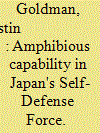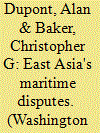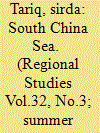| Srl | Item |
| 1 |
ID:
133377


|
|
|
|
|
| Publication |
2014.
|
| Summary/Abstract |
Today the Japanese face an increasingly complex regional-security environment, particularly along the southwestern islands, where incursions by Chinese government vessels are increasingly occurring in what Japan claims as its territorial waters. The security of offshore islands has developed as an area of focus within Japanese defense planning, and Japan has begun building up modest island-defense capabilities.1 Although the nature and range of threats faced have evolved, a core focus of the Japan Self-Defense Force (JSDF ) remains the same- the requirement to protect the nation from an amphibious invasion.2 While the JSDF has developed some robust platforms, its current state also reflects the constraints placed on its development under the 1947 constitution, enacted during the occupation following World War II. …
|
|
|
|
|
|
|
|
|
|
|
|
|
|
|
|
| 2 |
ID:
133778


|
|
|
|
|
| Publication |
2014.
|
| Summary/Abstract |
Few doubt that China's rise is this era's principal driver of strategic change, just as the United States' equally influential ascendancy shaped the last. But earlier optimism that the Middle Kingdom's re-emergence as a major power would be largely benign is fading as evidence mounts that Beijing is determined to press its territorial and resource claims in the vitally important seas of the Western Pacific. In barely the blink of a geopolitical eye, China's once lauded charm offensive has given way to exactly the kind of coercive behavior its critics have long predicted.1 In a 3,000-mile maritime arc running from the East China Sea to the southern reaches of the South China Sea, Beijing is at loggerheads with many of its neighbors, including erstwhile friends, over several linked territorial and resource disputes. If not wisely managed, these disputes could bring East Asia's long peace to a premature and bloody end.
|
|
|
|
|
|
|
|
|
|
|
|
|
|
|
|
| 3 |
ID:
133495


|
|
|
|
|
| Publication |
2014.
|
| Summary/Abstract |
A resurgent regional power in the Pacific has grown successively more aggressive in territorial claims to a number of disputed island groups. Unilaterally establishing air-defense identification zones and stoking nationalistic feelings among its population have spiked international tensions in the region as other nations resist this aggressive behavior. In this powder-keg situation, a tactical miscalculation on the part of one aggressor ship skipper results in a collision between opposing warships. Both countries begin mobilizing for war.
|
|
|
|
|
|
|
|
|
|
|
|
|
|
|
|
| 4 |
ID:
135567


|
|
|
|
|
| Summary/Abstract |
The South China Sea is now a principal node of global power politics, critical to the preservation of the world wide balance of power. While control of it may not quite unlock the world for china as control of the greater Caribbean unlocked the world of America; the Caribbean, even with the Panama Canal, has never lain astride the great maritime routes and energy to the degree that the South China Sea presently does.
|
|
|
|
|
|
|
|
|
|
|
|
|
|
|
|